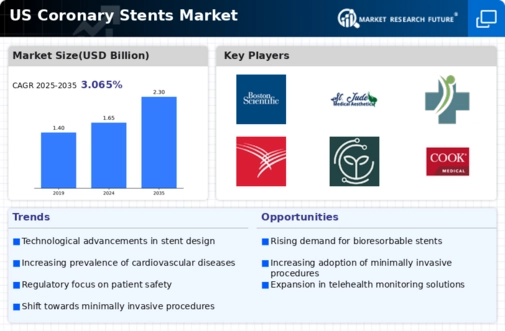Increasing Aging Population
The aging population in the US is a critical driver for the coronary stents market. As individuals age, the incidence of cardiovascular diseases tends to rise, leading to a higher demand for interventional procedures. According to recent statistics, approximately 15% of the US population is aged 65 and older, a demographic that is particularly susceptible to heart-related ailments. This demographic shift suggests a growing need for effective treatment options, including coronary stents. Furthermore, the coronary stents market is likely to experience increased sales as healthcare providers focus on addressing the needs of older patients. The combination of an aging population and the rising prevalence of heart diseases indicates a robust market potential for coronary stents in the coming years.
Rising Healthcare Expenditure
The increasing healthcare expenditure in the US is a significant driver for the coronary stents market. As healthcare budgets expand, hospitals and healthcare facilities are more likely to invest in advanced medical technologies, including coronary stents. In 2025, healthcare spending in the US is projected to reach approximately $4 trillion, with a substantial portion allocated to cardiovascular treatments. This financial commitment indicates a favorable environment for the coronary stents market, as healthcare providers seek to enhance patient care through innovative solutions. Additionally, the rise in insurance coverage for cardiovascular procedures further supports market growth, as patients gain better access to necessary treatments. The correlation between healthcare spending and the demand for coronary stents suggests a positive outlook for the industry.
Advancements in Medical Technology
Technological innovations play a pivotal role in shaping the coronary stents market. The introduction of drug-eluting stents and bioresorbable stents has revolutionized treatment options for patients with coronary artery disease. These advancements not only enhance the efficacy of stenting procedures but also reduce the risk of restenosis, thereby improving patient outcomes. The coronary stents market is witnessing a surge in demand for these advanced products, as they offer significant benefits over traditional stents. Market data indicates that the adoption of drug-eluting stents has increased by approximately 30% in recent years, reflecting a shift towards more effective treatment modalities. This trend suggests that ongoing research and development in stent technology will continue to drive market growth.
Growing Awareness of Cardiovascular Health
Public awareness regarding cardiovascular health is increasingly influencing the coronary stents market. Educational campaigns and initiatives aimed at promoting heart health have led to a greater understanding of the risks associated with cardiovascular diseases. As individuals become more informed, they are more likely to seek medical attention for symptoms related to heart conditions. This heightened awareness is driving demand for diagnostic and interventional procedures, including the use of coronary stents. The coronary stents market is benefiting from this trend, as healthcare providers respond to the growing need for effective treatment options. Furthermore, the emphasis on preventive care and early intervention is likely to sustain market growth, as patients are encouraged to prioritize their cardiovascular health.
Regulatory Support for Innovative Treatments
Regulatory bodies in the US are increasingly supportive of innovative treatments in the coronary stents market. The expedited approval processes for new stent technologies, such as bioresorbable stents, reflect a commitment to enhancing patient care. This regulatory environment encourages manufacturers to invest in research and development, leading to the introduction of advanced products that meet evolving patient needs. The coronary stents market is poised to benefit from this supportive framework, as it fosters innovation and competition among manufacturers. Additionally, the potential for faster market entry for new technologies may lead to increased availability of cutting-edge stent options for healthcare providers. This regulatory landscape suggests a promising future for the coronary stents market as it adapts to the demands of modern medicine.






















Leave a Comment